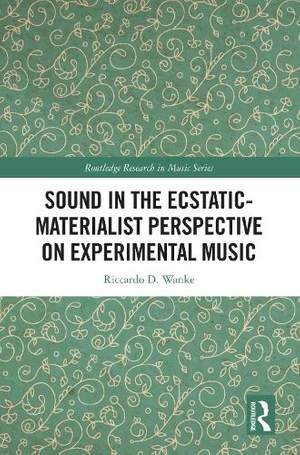
Sound in the Ecstatic-Materialist Perspective on Experimental Music
- Author: Wanke, Riccardo D.
Book
$55.75Out of Stock
Contents
- Introduction
- A multifaceted approach
- Overview
- Remarks and limitations
- Notes
- 1 Sound in 20th-century music
- Scelsi and the centrality of sound
- Key aspects of sound in the ecstatic-materialist perspective
- From music to sound
- From the beginning of the century up to 1980: a plural emancipation
- Spectral line
- Minimalist line
- Musique concrète and avant-garde lines
- From the 1980s onwards: a non-linear expansion
- Sonic map
- Case studies: selection of pieces
- Closing remarks
- Notes
- 2 Morphology and structure of musical works
- Starting points of the analysis
- Sequential method
- Step 1: Identification of common characteristics and morphologies
- Step 2: Identification of common developments (unfolding structures)
- Results
- Low-level attributes
- (A) An expanded spectrum
- (B) Microtonal variations
- (C) Systematic glissandi
- (D) Rhythmic development
- (E) Static masses
- (F) Repetitive clusters
- (G) Dynamic and timbric contrasts
- High-level attributes
- (H) Hypnotic reiterations
- (I) A plastic and sculptural arrangement of sound
- (J) Restricted number of elements conceived globally
- (K) Limited dialectic among elements
- (L) Sonic challenges
- (M) Micro-/macroconstructions
- Specific piece: in vain
- Perceptual grammar
- Closing remarks
- Notes
- 3 Listening
- Listening to experimental music
- The experimental music blind spot in studies on musical perception
- The auditory process of E-M music
- Early-stage perception
- Late-stage perception
- Listening survey
- Results
- Music training discrimination
- Cross-genre connections
- Modes of listening
- The internal-external immanent domain
- Towards a multifaceted listening mode
- The aesthetic attitude
- Closing remarks
- Notes
- 4 Composers and performers
- Dialogues
- Musical contexts and genres
- Perception and the space of listening
- Compositional practice
- Sound and time
- Closing remarks
- Notes
- 5 The ecstatic-materialist perspective
- The ecstatic and the materialist
- Phenomenological materiality: the imprint of sound
- Ecstatic potential: sound-as-trace
- External-internal
- Sound in the ecstatic-materialist perspective
- Unity
- Unstable presence
- Coherence and convergence
- Personality and intention
- Intimate temporality and repetition
- Space-matter: the materiality of space in sound
- Vertical time: the ecstatic potential of space-matter
- Musical communication
- Closing remarks
- Notes
- 6 Going beyond sound-in-itself
- The conceptual and the sensorial-perceptual paradigms
- Sonic materialism and the philosophical debate around sound
- The materiality of the ecstatic-materialist perspective
- The proximal hypothesis: the material presence of space-matter
- The embodied cognitive level
- Going beyond sound through sound
- Notes
- 7 Epilogue: The ecstatic-materialist perspective in context
- The ecstatic-materialist context
- Empowered listening
- Closing remarks
- Notes
- Discography
- Bibliography
- Glossary
- Index



